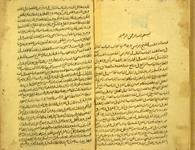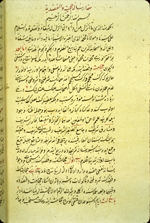Catalogue: Medical Monographs
-
 Maqālah fī al-faṣd (MS A 58.1)
Maqālah fī al-faṣd (MS A 58.1) - (An Essay on Bloodletting)
- مقالة فى الفصد
- or Maqālah al-amīnīyah fī al-faṣd
- (Amin's Essay on Bloodletting)
- مقالة الامينية فى الفصد
- by Amīn al‑Dawlah Abū al‑ḥasan Hibat Allāh Ibn al-Tilmīdh (d. 1154/549 or 1165/560)
- امين الدوله ابو الحسن هبة الله ابن التلميذ
This essay on phlebotomy (faṣd) by Ibn al-Tilmīdh, an important and prolific physician working in Baghdad, is a short treatise divided into 10 chapters (babs). It circulated under two titles, the first simply reflecting the subject matter and the second (Maqālah amīnīyah fī al-faṣd or Amin's Treatise on Bloodletting) referring to the fact that it was composed by Amīn al‑Dawlah Ibn al-Tilmīdh. In medieval literature Ibn al-Tilmīdh is more commonly referred to as Amīn al‑Dawlah than by the latter part of his name (Ibn al-Tilmīdh) that modern scholars tend to prefer.
The copy now at NLM gives a slightly different title (Risālah al-faṣd) and does not name Amīn al‑Dawlah Ibn al-Tilmīdh as the author, but rather attributes it to Ibn Sīnā (Avicenna), who is referred to by his common medieval designation "al-Shaykh al-Ra'is". A comparison with two copies of the treatise now in London, at the Wellcome Trust Library for the History and Understanding of Medicine (MS Arab. 9 and MS Arab. 129), as well as the modern edition of Ibn al-Tilmīdh's treatise, demonstrates clearly that the NLM copy is of a treatise by Ibn al-Tilmīdh and not by Avicenna.
The treatise has been recently edited: Ibn al-Tilmīdh, Maqālah fī al-faṣd, ed. by Subhi Mahmud Hammami (Aleppo: Ma‘had al-Turath al-‘llmi al-‘Arabi, 1997). The NLM manuscript was not used in the edition, which employed two manuscripts: Oxford, Bodleian Library, MS Hunt 421, item 4, and Damascus, Maktabat al-Asad al-Wataniyah (former Dar al-Kutub al-Zahiriyah), MS 5064, item 6.
For other copies, see Ullmann, Medizin, p. 163 nt. 7; GAL vol. 1, p. 488-9 (642); Iskandar, "Wellcome", pp. 130-1; and Savage-Smith, "Bodleian", MS Hunt 421, item 4.
The treatise has not been translated into a modern language.
Maqālah fī al-faṣd (MS A 58.1)
Illustrations
The opening of an essay on phlebotomy, or bloodletting, by Ibn al-Tilmīdh, who worked in Baghdad and died in either 1154/549 or 1165/560. In the copy it is stated that the treatise is by al-Shaykh al-Ra’īs, which is a common designation of Ibn Sīnā (Avicenna). A comparison with other copies, however, demonstrates that it is the essay by Ibn al-Tilmīdh. The copy is undated, probably late 18th century.
Physical Description
Arabic. 7 leaves (fols. 1b-7b). Dimensions 19.5 x 10.8 (text area 15.8 x 8.1) cm; 24-25 lines per page. The title is given as Risālah al-faṣd on fol. 1b,line 2, and (by a later hand) in a Persian form Risalat-i faṣd on the front cover. The author's name is given on fol. 1b, line 2, as al-Shaykh al-Ra’īs, a common designation of Ibn Sīnā (Avicenna), and on the front cover (in a later hand) as Abū ‘Alī Sīnā; this attribution is incorrect, for a comparison with other manuscripts demonstrates that this is a copy of the treatise on bloodletting written in 10 chapters (babs) by Ibn al-Tilmīdh, who is not named in this copy.
The copy is undated and unsigned. The appearance of the paper, ink, and script suggests a date of the late 18th century.
A complete copy. The text is written in a small, casual naskh script hand in uneven lines. The copyist appears to be the same as that of NLM MS A 66.1. There are catchwords.
There are some marginal corrections.
The paper is wormeaten.
The volume consists of 7 leaves. Fol. 1a is blank except for owners' signatures and stamps, the title Risalat-i faṣd, and supposed author Abū ‘Alī Sīnā.
Binding
The volume is bound in a paper-covered Middle Eastern library binding with leather spine and corners. There are recent endpapers and pastedowns.
Provenance
Fols. 1a has owners' signatures and stamps, one dated 1218 [1803-4].
No further information is available on its provenance or when it came into the collections of NLM. It was in the library by 1955, but it was not included in the Schullian/Sommer Catalogue of incun. & MSS..
References
Hamarneh, "NLM", p. 96.
NLM Microfilm Reel: FILM 55-42 no. 5
-
 Risālah ḥijamīyah wa-faṣdīyah (MS A 88/II)
Risālah ḥijamīyah wa-faṣdīyah (MS A 88/II) - (A Cupping and Bloodletting Essay)
- رسالة حجمية و فصدية
- by Muḥammad ibn Maḥmūd (fl. 1758/1171)
- محمد ابن محمود
This is a short treatise on cupping (ḥijam) and phlebotomy (faṣd) in Turkish by an otherwise unknown author, Muḥammad ibn Maḥmūd, who completed the writing in the month of Rajab in 1171 [= March-April 1758].
The NLM copy appears to be unique, for no other copy is recorded.
The treatise has not been published or translated.
Risālah ḥijamīyah wa-faṣdīyah (MS A 88/II)
Illustrations
The opening of a Turkish treatise on cupping and bloodletting by an otherwise unknown author, Muḥammad ibn Maḥmūd, who states at the end of the treatise that he completed writing it in the month of Rajab 1171 [= March-April 1758]. The copy was made in 1773/1187.
Physical Description
Turkish. 7 leaves (fols. 1b-7b). Dimensions 21.5 x 15 (text area 16.2 x 7.5) cm; 21 lines per page. The title is given on fol. 1b, line 1 as Risālah ḥijamīyah wa-faṣdīyah, which is grammatically incorrect. The author is named on fol. 1b, line 6. According to a statement on fol. 7b, lines 1-2, the author completed the treatise in the month of Rajab 1171 [= 11 March-9 April 1758]. The author is otherwise unknown.
The copy is dated 1187 [= 1773 or 1774] in the colophon (fol. 7b, lines 9-10). The copyist is not named.
A complete copy. The text is written in a medium-small naskh script, tending toward nasta‘liq, in black in with purplish-red headings and overlinings. There are catchwords.
There are some marginal notations.
The biscuit paper has wavy laid lines and single chain lines which are barely visible. There are no visible watermarks.
The volume consists of 7 leaves. Fol. 1a is blank.
Binding
The volume is bound in a tan leather modern library binding with envelope flap. There are modern paper endpapers and pastedowns.
Provenance
The manuscript is bound together with three unrelated manuscripts: MS A 88/I, MS A 88/III, MS A 88/IV.
The volume was purchased in 1941 by the Army Medical Library from A. S. Yahuda (ELS 3327).
References
Schullian/Sommer, Cat. of incun. & MSS., entry A 88 , p. 327.
NLM Microfilm Reel: FILM 48-129, no. 5












